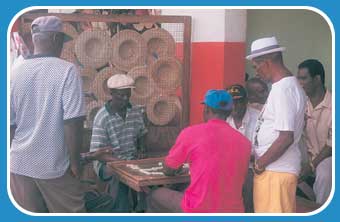| |
The original inhabitants of St Lucia were Amerindians from South America. They were joined by the Arawak Indians in 400 AD, but four hundred years later, they lost control to the more warrior-like Carib Indians. Despite fierce resistance by the Carib Indians, European settlers colonised the island in the 17th century. The settlers established sugar cane and banana plantations, using African slaves for labour.
For two centuries, the French and the British fought over the island. Control changed hands fourteen times before it became a British colony in 1814. In 1967, St Lucia became an independent country.
| Playing dominoes, a popular pastime in St Lucia. |

©Garrett Nagle |
Today, the population of St Lucia is about 160,000, of which 90% are descended from the vast numbers of African slaves. The island's distinctive Anglo-French Creole culture reflects the mixture of influences from the past. English is the official language but many people use French-based Creole for everyday communication.

©Garrett Nagle
|
About a third of the population live in the capital city, Castries. As well as the main market areas, people in the poorer neighbourhoods of Castries set up their own businesses to make a living, like this bakery in La Toc Road. Go to the next page to find out more about the kind of jobs people do in St Lucia. |
|
|





